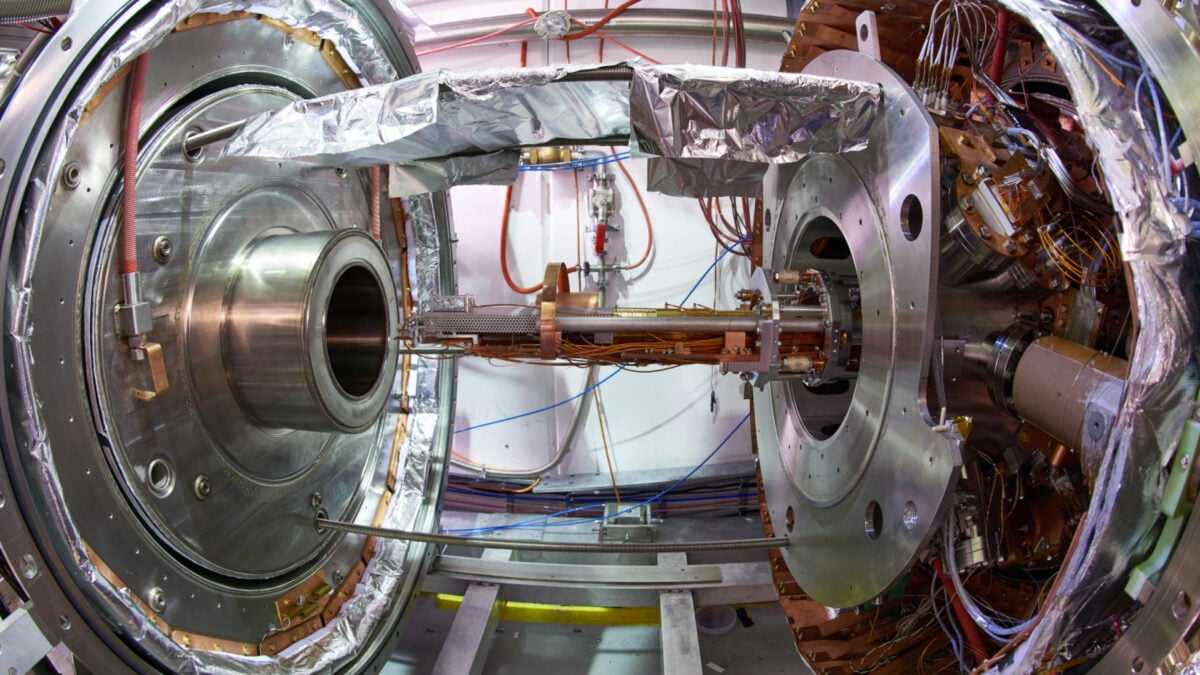Physicists Create First-Ever Antimatter Qubit, Making the Quantum World Even Weirder

Readers following our existential physics coverage may remember a recent breakthrough from CERN concerning matter’s evil twin, antimatter. An outstanding mystery in physics is that our universe contains more matter than antimatter, contradicting most theoretical predictions. Scientists, therefore, understandably want to explain why and how this is the case.
CERN announced yet another significant leap for studying antimatter—and this time, the achievement creeps into the realm of quantum computing. In a Nature paper published on July 23, CERN’s Baryon Antibaryon Symmetry Experiment (BASE) collaboration announced the first-ever demonstration of an antimatter quantum bit, or qubit—the smallest unit of information for quantum computers.
The qubit in question is an antiproton, a proton’s antimatter counterpart, caught in a curious quantum swing—arcing back and forth between “up” and “down” spin states in perfect rhythm. The oscillation lasted for 50 seconds. The technical prowess that enabled this result represents a significant leap forward in our understanding of antimatter, the researchers claim.
For the experiment, the team applied a technique called coherent quantum transition spectroscopy, which measures—with chilling precision—a particle’s magnetic moment, or its behavior inside magnetic fields. First, the team brought in some antiprotons from CERN’s antimatter factory, trapping the particles in an electromagnetic Penning trap—a superposition of magnetic fields. Next, they set up a second multi-trap inside the same magnet, extracting individual antiprotons to measure and tweak the particle’s spin states in the process.
Quantum states are fragile and easily disturbed by outside distractions. The wrong push can immediately send them spiraling down the drain toward decoherence—at which point the system loses the valuable information physicists hope to find. This fundamental limitation of quantum systems was a major concern for the BASE collaboration, who in 2017 used a similar setup to the new experiment to confirm that protons and antiprotons had practically identical magnetic moments.
The team made substantial revisions to its technology, paying special attention to developing the mechanisms needed to suppress and eliminate decoherence. This hard work paid off; the antiproton performed a stable quantum swing for 50 seconds—a motion akin to how qubits exist in superpositions of states, which theoretically could allow them to store exponential loads of information. Additionally, it marked the first time physicists observed this phenomenon in a single free nuclear magnetic moment, whereas previous experiments had only seen it in large groups of particles.
“This represents the first antimatter qubit and opens up the prospect of applying the entire set of coherent spectroscopy methods to single matter and antimatter systems in precision experiments,” BASE spokesperson Stefan Ulmer said in a statement.

That said, the team doesn’t believe the new results will introduce antimatter qubits to quantum computing, at least not anytime soon.
“It does not make sense to use [the antimatter qubit] at the moment for quantum computers, because, simply speaking, engineering related to production and storage of antimatter is much more difficult than for normal matter,” Latacz explained, adding that since matter and antimatter are known to share fundamental properties, opting for the latter wouldn’t make practical sense. “However, if in the future [we find] that antimatter behaves differently than matter, then it may be interesting to consider this.”
There are additional improvements the team hopes to make, which will happen sometime very soon, Latacz said. The upgrades to BASE—termed BASE-STEP—will greatly improve our capacity to study antiprotons with higher precision and allow us to “improve the measurement of the magnetic moment of the antiproton by at least a factor of 10, and in a longer perspective even a factor of 100,” she said.
The new breakthrough could contribute to engineering advances in quantum computing, atomic clocks, and other areas. But as the researchers emphasize, such technological applications aren’t anything we should expect any time soon. Nevertheless, the result itself presents some fascinating lessons for fundamental physics—questions that may take years to answer, but to quote physicist Sean Carroll from the other recent CERN finding, “Well, it’s a small part of a much bigger puzzle—but you know, every part matters.”









